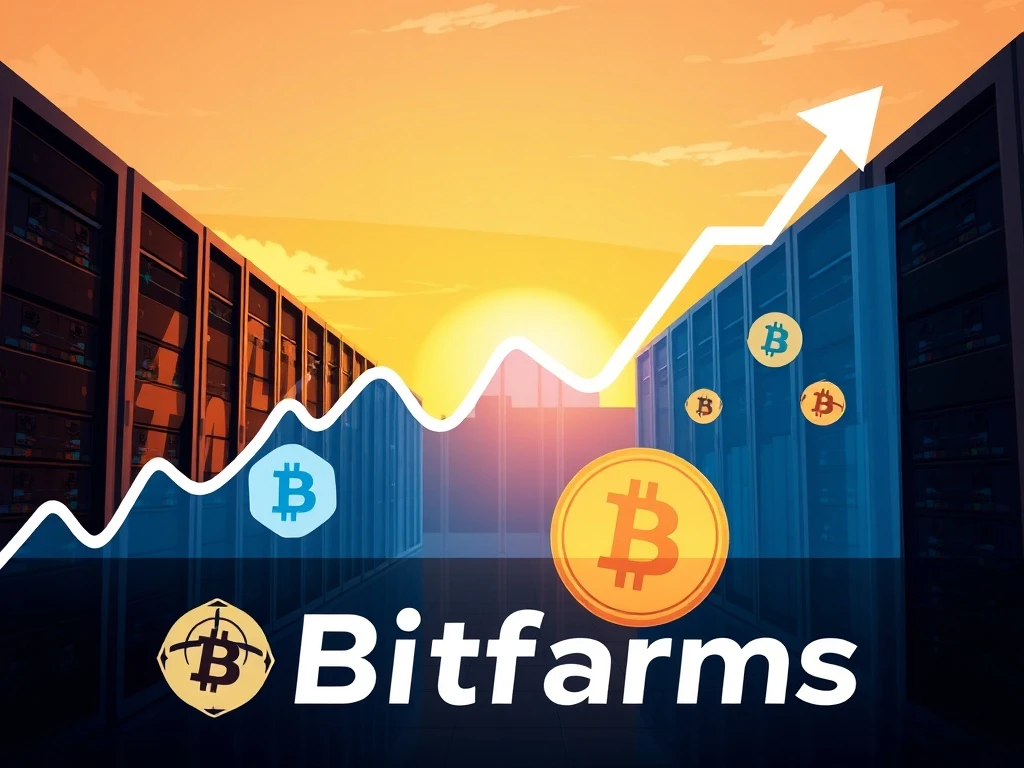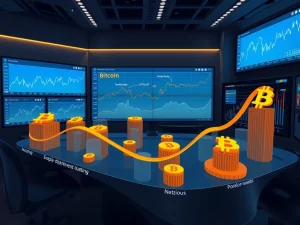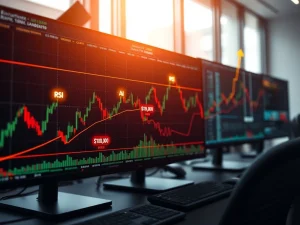Bitfarms’ Bold Share Buyback Sparks Astonishing 14% Stock Surge

In a move that sent ripples through the crypto market, Bitfarms Ltd. (Nasdaq/TSX: BITF), a prominent player in the Bitcoin mining sector, recently announced a significant share repurchase program. This strategic decision immediately triggered an impressive 14% surge in its stock price, signaling strong investor confidence and sparking conversations across the digital asset landscape. What does this mean for the future of Bitfarms and the broader crypto mining industry?
Bitfarms’ Strategic Share Buyback: A Bold Declaration of Value
On July 22, 2025, Bitfarms unveiled its plan to buy back up to 49,943,031 common shares, representing 10% of its public float. This program, set to run from July 28, 2025, to July 27, 2026, involves transactions on both the Toronto Stock Exchange (TSX) and Nasdaq. Daily repurchase limits are set at 494,918 shares on the TSX and up to 5% of outstanding shares annually on Nasdaq [1].
The immediate market reaction was palpable. Reports from AInvest highlighted a 14% post-announcement rally, while CoinDesk noted an 8% intraday jump [2, 3]. This decisive action reflects management’s strong belief in the company’s intrinsic value, with CEO Ben Gagnon articulating, “We believe our shares are undervalued because the market underappreciates the Bitcoin business and the HPC potential” [1].
This move isn’t just about reducing outstanding shares; it’s a powerful statement. It suggests that Bitfarms views its own shares as the best investment opportunity available, a sentiment that often resonates positively with investors looking for signs of a confident, well-managed company.
Why Is Bitfarms Investing in Itself? The Undervaluation Narrative
The core of Bitfarms’ decision lies in its perception of undervaluation. CEO Ben Gagnon’s statement underscores a belief that the market isn’t fully grasping the company’s strengths, particularly its dual focus on robust Bitcoin mining operations and its burgeoning potential in High-Performance Computing (HPC). Bitfarms aims to leverage its energy assets in Pennsylvania, which are key to driving growth in both these critical sectors.
This strategic rationale is built on several pillars:
- Market Disconnect: Bitfarms believes its current stock price doesn’t accurately reflect its operational efficiency, asset base, or future growth prospects.
- HPC Potential: The company sees a significant, underexploited opportunity in HPC, a sector increasingly vital for AI and other data-intensive applications. By integrating HPC, Bitfarms aims to diversify its revenue streams beyond pure crypto mining.
- Energy Assets: Its strategically located energy assets in Pennsylvania provide a competitive edge, allowing for more cost-effective and sustainable operations in both mining and HPC.
The inclusion of an automatic arrangement with a designated broker for transactions during blackout periods further highlights Bitfarms’ disciplined approach and commitment to executing the program effectively, even during sensitive periods [1].
The Impact of a Share Buyback on BITF Stock and Beyond
A share repurchase program, especially of this magnitude, has several potential implications for a company’s stock and its overall financial health. For BITF stock, the immediate impact was a clear surge, but the long-term effects are what truly matter.
Here’s a breakdown of the typical benefits and potential considerations:
| Potential Benefits of a Buyback | Considerations/Challenges |
|---|---|
| Boosts Earnings Per Share (EPS): Fewer outstanding shares mean the same earnings are distributed among fewer shares, increasing EPS. | Opportunity Cost: Capital used for buybacks could otherwise be invested in R&D, acquisitions, or organic growth. |
| Signals Confidence: Management’s belief that shares are undervalued can instill confidence in investors. | Market Dynamics: Program effectiveness is still subject to broader market conditions and investor sentiment. |
| Reduces Equity Dilution: Counteracts dilution from stock options or future share issuances. | Execution Risk: The actual impact depends on how efficiently and effectively the buyback is executed. |
| Supports Stock Price: Creates demand for shares, potentially preventing further declines or aiding recovery. | Short-Term vs. Long-Term: While boosting short-term metrics, long-term value creation requires sustained operational success. |
While the market reactions have been largely positive, critics have questioned whether the allocated $64 million could be better utilized for organic growth projects [3]. However, the predefined limits and regulatory adherence underscore Bitfarms’ disciplined approach, suggesting a balanced strategy for capital allocation.
Crypto Mining and HPC: A Strategic Evolution?
Bitfarms’ emphasis on HPC potential underscores a broader industry shift. While its commitment to Bitcoin mining remains steadfast, the integration of high-performance computing represents a strategic pivot that could redefine its market perception and future revenue streams.
This dual focus positions Bitfarms to:
- Diversify Revenue: Reduce reliance solely on Bitcoin price fluctuations by tapping into the growing demand for computing power in AI, machine learning, and other data-intensive fields.
- Optimize Assets: Leverage existing energy infrastructure and technical expertise for both mining and HPC, maximizing the utility of its significant investments.
- Attract New Investors: Appeal to a broader investor base interested in technology and AI, not just cryptocurrency.
For investors, this move signals a balance between short-term value creation through the buyback and long-term opportunities in energy and computing. Success will ultimately depend on Bitfarms’ ability to execute its repurchase strategy effectively while capitalizing on its Pennsylvania energy assets and delivering tangible results from its HPC ventures [1]. The evolution of Bitfarms from a pure-play miner to a computing infrastructure provider could mark a significant milestone in the broader crypto mining landscape.
Conclusion: A Confident Step Forward for Bitfarms
Bitfarms’ decision to launch a substantial share buyback program has clearly resonated with investors, leading to an immediate and significant surge in its stock price. This move is a powerful declaration of confidence from the company’s leadership, who believe that Bitfarms shares are currently undervalued, particularly given its strategic expansion into high-performance computing (HPC) alongside its core Bitcoin mining operations.
By leveraging its energy assets and pursuing a dual strategy of capital allocation and long-term growth, Bitfarms aims to enhance shareholder value, reduce equity dilution, and potentially boost earnings per share. While the success of this program will depend on diligent execution and broader market dynamics, it positions Bitfarms as a proactive player navigating the evolving landscape of digital assets and advanced computing. This bold step not only reflects a strong belief in its current business but also signals an exciting future where energy-efficient computing infrastructure plays a central role.
Frequently Asked Questions (FAQs)
Q1: What is the Bitfarms share repurchase program?
A1: The Bitfarms share repurchase program authorizes the company to buy back up to 49,943,031 common shares, which is 10% of its public float, between July 28, 2025, and July 27, 2026. This is done on the TSX and Nasdaq to reduce outstanding shares.
Q2: Why did Bitfarms’ stock surge after the announcement?
A2: Bitfarms’ stock surged by up to 14% because the share buyback signals management’s strong confidence that the company’s shares are undervalued. This move often instills renewed investor confidence, suggesting a belief in the company’s future prospects and financial health.
Q3: What does CEO Ben Gagnon mean by “undervalued”?
A3: CEO Ben Gagnon believes Bitfarms shares are undervalued because the market doesn’t fully appreciate the strength of its core Bitcoin mining business or the significant potential it holds in the high-performance computing (HPC) sector. He sees these areas as under-recognized by current market valuations.
Q4: How does the share buyback benefit shareholders?
A4: A share buyback can benefit shareholders by reducing the number of outstanding shares, which typically increases earnings per share (EPS). It also signals management’s confidence, potentially stabilizing or increasing the stock price, and can reduce equity dilution.
Q5: What is Bitfarms’ strategy regarding High-Performance Computing (HPC)?
A5: Bitfarms is strategically expanding into HPC by leveraging its energy assets in Pennsylvania. This move aims to diversify its revenue streams beyond just Bitcoin mining, tapping into the growing demand for computing power needed for AI, machine learning, and other data-intensive applications. It represents a long-term growth opportunity.










